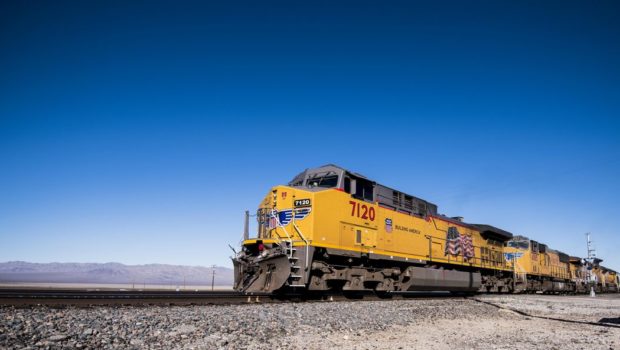Class 1 Railroads Need To Improve Their Performance By Investing In Technology
UNITED STATES - AUGUST 30: A Union Pacific freight train passes the railroad crossing in Nipton, ... [+]
My colleague Muhammad Wasay Rashid has just completed a market study on the adoption of Internet of Things (IoT) technologies by the global rail industry, including the freight segment. Mr. Rashid reports that sales of IoT technologies for Rail are bigger, and growing faster, in Asia and Europe. This article will explain why there are good reasons why North American Class 1 Railroads should be more aggressively investing in these technologies, particularly geolocation technologies.
IoT “things” are industrial smart devices, often sensors, that connect to the Internet and can collect useful data. In rail these IoT devices are used to improve rail operations in several ways. Rail applications that utilize the sensor data are Geolocation and Service Performance, Security, Train Control, and Maintenance.
Geolocation
IoT-based geolocation enables freight, or the empty cars shippers need to put their freight on, to be tracked. This solution empowers railway operators to locate their empty railway cars or track a customer's cargo on an outbound shipment.
In the US, Class 1 railways’ unfair, arbitrary, and illogical fines led to a groundswell of complaints and hearings by the Surface Transportation Board last year. While the bulk of the proceedings were focused demurrage and accessorial fines, shippers also took the opportunity to complain about poor service. Class 1’s estimated time of arrival (ETAs) performance is horrible. Rail carriers expect shippers to look on their computers to see where their cars are. But because cars pass from one rail line’s tracks to another, that means looking in multiple systems. ETAs are at the mercy of the least accurate leg of a trip. And the amount of time a car will spend at an interchange yard is particularly hard to predict. The whole idea that shippers should have to continually look online, instead of being provided updated ETAs, is ludicrous. Geolocation will improve North American shippers’ happiness, but Class 1 Railroads still need to work far harder to improve their service performance.
Security
Security includes video surveillance of trains, cars, and wayside assets to prevent theft or damage. Other IoT sensors can be used as well. Rail cars may have sensors that detect a car door’s motion – whether the door is being opened, light – another way to detect whether a rail car door open or closed, or vibration. Systems can be designed with geofences. A geofence is a GPS generated map perimeter for a real-world geographic area. If a rail car door is being opened outside a designated geofence location, it is likely that theft may be occurring. On some modes of transportation, vibration, humidity, and water sensors are used to determine whether cargo has been damaged on route and help to pinpoint the responsibility for that damage. That is far more common for Ocean than Rail.
Train Control
The main concept of train control – or “positive train control” as it is often referred to by North American Class 1 Railroads - is that the train receives information about its location and where it is allowed to safely travel. Train control helps prevent accidents by enforcing the train’s speed, including in areas where there are temporary speed restrictions. It is also used to improve rail worker safety for workers working next to track.
Equipment on board the train interfaces to a centralized train control application and aids in enforcing safety. The IoT visibility can be based on radio frequency identification (RFID) or the global positioning system (GPS). RFID in train involves tagging rail cars and having read stations along the track at certain intervals. RFID does not allow continual monitoring of a train’s location. The more read stations, the better the visibility. But GPS allows for almost continued monitoring of trains and is clearly a better form of IoT when it comes to train control. The Association of American Railroads reported in 2018 that Class 1 Railroads were using GPS for train control across over 83 percent of total freight mileage.
Maintenance
Maintenance applications use IoT sensors to transmit data like engine temperature, fuel mixtures, coolant levels, and many other forms of data. Infrared sensors can be used to track the condition of the tracks. Rail cars can have vibration and other sensors that determine the health of these assets.
This sensor data can be used for condition monitoring – the asset is in good shape or bad shape – or it can be used for predictive maintenance. In predictive maintenance, instead of scheduling maintenance for an asset after so many miles traveled, the maintenance is based on what sensor data and advanced analytics infer about the health of the rail asset. Predictive maintenance allows the maintenance budget stretch much further than traditional maintenance regimes. Predictive maintenance improves the reliability, safety, and the efficiency of the railway network.
Final Thoughts
Rail is a low-cost way to move bulk freight. Despite being significantly less costly than truckload, Class 1 Railroads have been steadily losing market share to truckload because of bad on-time performance. As new technologies like truck platooning and autonomous driving become real in the next several years, Class 1 Railroads are apt to see these market share losses increase dramatically.








Gloss